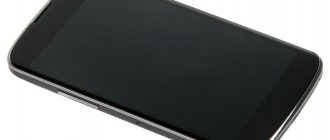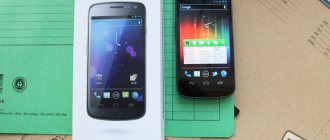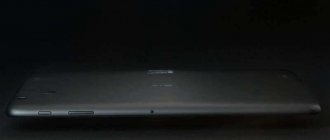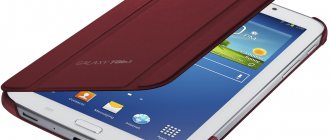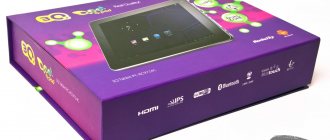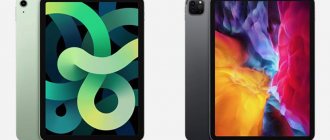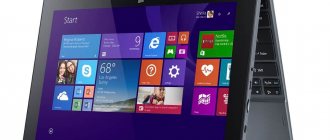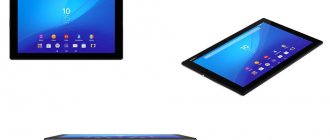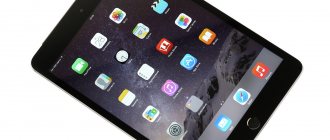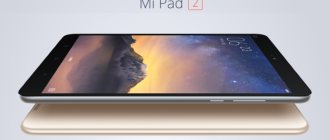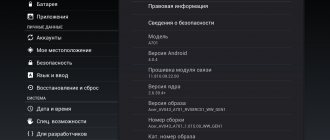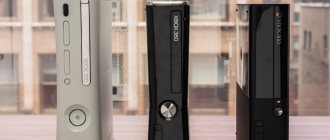The concept of the seven-inch Nexus tablet has not changed: the tandem of the two largest companies in their industries - ASUS and Google - is still trying to make a modern and powerful gadget, but at the same time accessible to the masses. If you compare the characteristics of the new device and the previous model, you will notice that almost everything in it has been improved: the screen, computing resources, the amount of RAM, and even a rear camera has appeared. It seems that in the new Nexus 7 the developers have done a total work on bugs and corrected the vast majority of the shortcomings of the previous model. Or at least tried to do so. Did they succeed?..
⇡#Appearance and ergonomics
ASUS/Google Nexus 7 (2013) - factory box
The exterior of the new Nexus 7 has changed slightly. The tablet is generally similar to its predecessor, but there are some differences - and very significant ones - in the appearance of the device. Perhaps the most important of them: the tablet has lost two millimeters in thickness - from 10.7 mm to a much more acceptable 8.7 mm. In addition, it has become lighter - the Nexus 7 of 2013 with a built-in modem weighs 300 g, and without it 290 g. The previous model was heavier - 335 grams without a cellular module and about the same 10 grams more in the 3G version.
ASUS/Google Nexus 7 (2013) - front panel
The shape of the body remains the same, elongated. larger display could fit into the Nexus 7 body . There are no physical keys on the front panel - all navigation keys are touch sensitive and are located directly on the screen. Why the developers needed so much free space around the display is unclear. This is probably required by the internal design of the device. On the left side there is a 1.2-megapixel front camera lens and a sensitive sensor area.
ASUS/Google Nexus 7 (2013) - full face
The back panel of the tablet is made of plastic with a soft-touch matte finish that is pleasant to the touch. Unfortunately, the “back” of the new Nexus 7 tends to quickly collect “fingers” and dust—to keep the device looking attractive, it will have to be wiped down periodically. Unlike the 2012 version, the back panel is smooth rather than textured. As befits any self-respecting mobile device, the “back” of the updated Nexus 7 is non-removable.
ASUS/Google Nexus 7 (2013) - back panel and sides
The sides of the tablet have lost the overtly plastic-looking silver-plated edging, thanks to which the device began to look more strict and representative. The layout of the various elements of the tablet is standard, and therefore everything is in order with ergonomics. The lock/power and volume keys are located on the top edge of the tablet. There is also a tray for a micro-SIM card, which can be opened with a paper clip. The micro-USB 2.0 interface (which is actually not micro-USB at all, but SlimPort - a variation on the MHL theme, we’ll talk about it in more detail below) is located on the right side of the case, and the 3.5 mm audio jack is on the left. A pair of speakers are located on the rear panel.
ASUS/Google Nexus 7 (2013) - micro-SIM card tray on the top end
The tablet is assembled well. When you squeeze the sides, characteristic colored streaks do not appear on the screen - the Nexus 7 matrix has a chance to survive some not too painful blows of fate. Inside the tablet there is a durable magnesium alloy frame that gives the structure the necessary rigidity. But all the external parts of the case are made of plastic - so you should handle the tablet carefully; it does not tolerate a “hard landing” very well.
In the video above, you can take a look at the Nexus 7 (2013) drop test: our colleagues at Android Authority dropped it several times on a concrete sidewalk and described in detail all the damage received.
Everything you wanted to know about Nexus 5X and Nexus 6P - Google's new smartphones
Nexus 6P
As expected, this is the result of the company's cooperation with Huawei. The new product has an anodized aluminum body and three colors: white, gray and dark. The 5.7-inch 2,560 × 1,440 WQHD AMOLED screen, thanks to thin frames around it, occupied 74% of the front part of the smartphone, leaving room for a 5-megapixel front camera and stereo speakers.
Dave paid special attention to the updated cameras. The smartphones received 12.3-megapixel sensors from Sony, which can be used by double pressing the lock key. With 1.55 micron pixels, the 6P should handle low light conditions well.
It's an amazing camera.
At the presentation there were many comparisons with the iPhone, and when it came to evening photography, the Google smartphone, as expected, turned out to be better. We can only hope that this is actually the case, because given the f/2.2 aperture of the iPhone camera, it is not so difficult to take precedence in this aspect.
They didn’t ignore another strong point of the iPhone - shooting slo-mo video. Here the 6P doesn't lag behind and provides frame rates of up to 240 per second. The same goes for 4K video recording. In addition, a rather strange “Photo Series” mode has appeared: the smartphone takes pictures in a row at a speed of 30 frames per second, after which you can make GIFs from them or select the best one.
Separately, Dave spoke about the new Imprint fingerprint sensor, which will be integrated into the system at the software level, and thanks to a special SDK, developers will be able to access it.
According to Burke, it only takes a few seconds to remember a fingerprint, and recognition occurs in less than 0.6 seconds. In addition to its main function, Imprint, similar to Touch ID, can be used to quickly make payments.
The smartphone is built on a platform with a 64-bit Qualcomm Snapdragon 810 v2.1 processor with a frequency of 2 GHz and Adreno 430 graphics, and the RAM in the new product is as much as 3 GB, and even of the LPDDR4 standard. In addition, the new Nexus received an auxiliary coprocessor that controls motion sensors and an accelerometer. Thanks to this, smartphones know when you pick them up and automatically turn on the screen and display an Ambient screen with the most important information, which, thanks to the use of AMOLED screens, consumes virtually no energy. By the way, the battery capacity of the Nexus 6P is 3,450 mAh.
The new Nexus also received a USB Type C port with increased data transfer speeds and fast charging. The price of the new product starts at $499 for the 32 GB version.
Nexus 5X
The second new product repeats the Nexus 6P in almost everything and is perceived as its slightly smaller version. Here the screen is half an inch smaller, and the battery is 20% larger than its predecessor, and exactly the same amount smaller than the flagship 6P. Its capacity is 2,700 mAh.
Instead of aluminum, there is Soft-touch plastic in three colors: Carbon Black, Sports White and Ice Blue. Otherwise, everything here is the same as in 6P, with the exception of slow motion only at 120 fps. This is due to the weaker Qualcomm Snapdragon 808 processor with a frequency of 1.8 GHz and the Adreno 418 graphics chip. In addition, the Nexus 5X comes with only 2 GB of LPDDR3 RAM.
The price of the new product in the basic version with 16 GB is $379, the 32 GB model will cost $429, and the start of sales of both smartphones is scheduled for October. New Nexus owners will also get three months of free Google Play Music.
Optionally, for an additional $69 for the Nexus 5X and $89 for the Nexus 6P, you can get an extended two-year Nexus Protect warranty, which covers even accidental drops of the devices. In this case, your smartphone will simply be replaced within a day.
Android 6.0 Marshmallow
At the presentation, they mainly talked about previously announced functions of the system. And yet, they talked about a couple of new features that will delight Android smartphone users.
The first - Now on Tap - adds context inside the system. Works in any Android application and allows you, for example, from discussing a place for dinner on WhatsApp to quickly find and book the restaurant that is mentioned.
Another interesting change in the voice assistant is the emergence of Voice Interactions, which developers will be able to implement into their applications. This will provide dialogs not only for system functions, but also for third-party solutions.
In addition, the system has a Doze mode, which detects moments when the phone is inactive and puts it into sleep mode to save battery.
The update will reach Nexus smartphones within a week.
What do you think about the update to the Nexus line? We are waiting for your impressions in the comments.
⇡#Technical characteristics
| ASUS/Google Nexus 7 (2012) | ASUS/Google Nexus 7 (2013) | |
| Display | 7.0 inches, 1280x800, IPS | 7.0 inches, 1920×1200, IPS |
| Touch screen | Capacitive, up to 10 simultaneous touches | |
| Air gap | No | |
| Oleophobic coating | Eat | |
| Polarizing filter | Eat | |
| CPU | NVIDIA Tegra 3 T30L : four cores ARM Cortex-A9 (ARMv7), up to 1.2 GHz (up to 1.3 GHz single-core); one ARM7 core (ARMv4T) 40 nm process technology | Qualcomm Snapdragon S4 Pro APQ8064 : four Qualcomm Krait cores (ARMv7); frequency 1.5 GHz; 28 nm LP process technology |
| Graphics controller | NVIDIA GeForce ULV, frequency 416 MHz | Qualcomm Adreno 320 |
| RAM | 1 GB DDR3L-1333 | 2 GB DDR3L-1600 |
| Flash memory | 8/16/32 GB | 16/32 GB |
| Connectors | 1 x Micro-USB 2.0 1 x 3.5mm headset jack | 1 x Micro-USB 2.0 (SlimPort) 1 x 3.5mm headset jack |
| cellular | 2G/3G (optional), Micro-SIM | 2G/3G/4G (optional), Qualcomm MDM9215M modem, WTR1605L transceiver , Micro-SIM |
| Cellular connection 2G | GSM/GPRS/EDGE 850/900/1800/1900 MHz | |
| Cellular 3G | HSPA+ (21 Mbps) 850/900/1700/1900/2100 MHz | DC-HSPA+ (42 Mbps) 850/900/1700/1900/2100 MHz |
| Cellular 4G | No | LTE Cat. 3 (102 Mbps) band 1, 2, 3, 4, 5, 7 , 20 (European version) |
| WiFi | 802.11b/g/n | 802.11a/b/g/n, 2.4/5 GHz |
| Bluetooth | 2.1 | 4.0 |
| NFC | Eat | |
| IR port | No | |
| Navigation | GPS, A-GPS (Broadcom BCM4751) | GPS, A-GPS, GLONASS (Qualcomm MDM9215M) |
| Sensors | Light sensor, accelerometer/gyroscope, magnetometer (digital compass) | Light sensor, proximity sensor, accelerometer/gyroscope, Hall sensor (digital compass) |
| Main camera | No | 5.0 MP (2592×1944), autofocus, no flash |
| Front-camera | 1.2 MP, no autofocus | 1.2 MP (1280×768), without autofocus |
| Nutrition | Non-removable battery 16 Wh (4325 mAh, 3.7 V) | Non-removable battery 15 Wh (3950 mAh, 3.7 V) |
| Wireless charger | No | Yes (Qi-compatible) |
| Size, mm | 196×120x10.9 | 200×114x8.7 |
| Weight, g | 335 | 290 (Wi-Fi version) 300 (4G version) |
| Water and dust protection | No | |
| operating system | Google Android 4.1.2 (Jelly Bean) | Google Android 4.3.1 (Jelly Bean) |
| recommended price | From 9,990 rubles | 10,990 rubles for the 16 GB version without LTE 14,990 rubles for the 32 GB version with LTE |
ASUS/Google Nexus 7 (2013) - information about the system and hardware
"Full HD" in seven inches
Last year, Google did not waste time on trifles and built a high-quality IPS display and a 4-core processor into a small tablet. True, in the end it turned out that a cheap and not very efficient SoC NVIDIA Tegra 3 model was used. This year the company was completely in trouble, and it equipped the new product with almost top-end hardware - with a margin, so to speak.
The resolution of the 7-inch display based on the IPS matrix is 1920x1200 pixels , and this is a density of 323 ppi . For comparison, in the iPhone 5 this parameter is 326 ppi, and in the iPad 4Gen it is 264 ppi. It’s better not to remember the iPad mini with its 163 ppi.
In addition to the high resolution, the Nexus 7 (2013) display has a huge brightness of 590 nits and a contrast ratio of 1300:1 (in the iPad mini 380 nits and 650:1). The picture the new product produces is amazing. This is the best display among compact tablets on the market.
But to make all these pixels “dance” effectively, you need serious stuffing, and this time the company made no compromises. The heart of the tablet is the 4-core SoC Qualcomm Snapdragon S4 Pro , and not quite an ordinary one, but the APQ8064 model, built on the basis of Krait 300 computing cores, not Krait 200. 300s are also used in the more productive Snapdragon 600 system-on-chip In fact, the solution in Nexus 7 differs from the latter only in the frequency reduced from 1.7 GHz to 1.5 GHz. Adreno 320 is used as a graphics accelerator .
Photo source: AnandTech
What can I say other than “Bravo, Google!” Considering the cost of the product in the US (from $240), the company has screwed up all its partners who produce tablets based on the Android OS.
Naturally, there is no talk of any “brakes” in the system. Although, when I downloaded personal applications from Google Play automatically after setting up my account, the client seriously crashed, but this is clearly a software problem.
By the way, about the software. The tablet came into my hands with Android 4.2 OS on board, but immediately offered to update after selecting the language and entering the password for the caught Wi-Fi network. “Okay, update,” I said and clicked on the “I want!” button. The device updated, forgot about my choice of language and password for the Wi-Fi network, asked about it again, after which it again offered to update, this time to Android 4.3 . It is unclear which version was installed before. Android is Android.
However, after the update, the adventures ended and the system began to rustle, as they say, which is greatly facilitated by 2 GB of built-in RAM (for comparison, 1 GB in the first generation Nexus 7 and 512 MB in the iPad mini).
Among other hardware features of the second generation Nexus 7, it is worth mentioning the presence of a Bluetooth 4.0 module, dual-band 802.11a/b/g/n (2.4 and 5 GHz), NFC and an induction ring for wireless charging (Qi standard is supported). The optional LTE module does not support Russian frequencies, but in our realities it can work with GSM and HSPA protocols.
⇡#Display: several paragraphs of pure delight
The display is completely new: only the diagonal remains the same. To begin with, Google/ASUS changed the supplier: screens for the new Nexuses are now produced by Japan Displays, and not by the Korean Hydis, whose matrices were somewhat peculiar. The resolution has increased: it is now 1920x1200 instead of the previous 1280x800. Accordingly, the density of dots increased by one and a half times: from 215 to 323 ppi.
This is the first 7-inch tablet with such a “fine-grained” pixel that came into our test laboratory. It is almost impossible to see individual dots on the display - at least if you do not hold the display close to your eyes. Fonts on the screen of the updated Nexus 7 look very sharp and smooth: reading electronic documents is a real pleasure!
ASUS/Google Nexus 7 (2013) - AnTuTu MultiTouch Test results
The touch screen supports up to ten simultaneous clicks, the tablet accurately and quickly recognizes touches and gestures. The display of the new Nexus 7 has all the signs of humanism: it does not have an air gap, but it does have a grease-repellent layer and a polarizing filter. All this has a positive effect on working with the device in bright light.
The display of ASUS/Google Nexus 7 (2013) has a truly impressive brightness reserve: the luminosity of the white field at the maximum backlight level reaches 475 cd/m2, and at the minimum - about 23. Such wide frames allow you to comfortably use the tablet in any conditions - starting from pitch darkness and ending with a hot, cloudless afternoon; the eyes will not ask for mercy. The device is equipped with a sensor for automatically adjusting a comfortable level of screen brightness, which copes with its tasks very well.
The maximum black field luminosity at the highest backlight level is 0.54 cd/m2. The static contrast of the display is therefore very high - approximately 875:1. Blacks look quite deep even at the maximum backlight level.
As it turns out, the main feature of the Nexus 7 display lies not in its excellent physical characteristics, but in its excellent calibration. The color temperature of shades of gray varies from 7076 to 7467 K; on average - about 7200 K, close to the reference value of 6500 K. The image is moderately warm, just as it should be, without unpleasant deviations.
Gamma curves for both grayscale and color components almost completely coincide with the reference curve. There is nothing to comment on - the color rendition of the display of the new Nexus 7 is very close to the only correct one. There are no unwanted highlights or gaps in the shadows. Such color rendition should definitely be appreciated by people of creative professions - for example, designers and photographers.
ASUS/Google Nexus 7 (2013) - tablet screen color gamut (black triangle) compared to sRGB space (white triangle)
The color gamut of the display is almost the same as the standard sRGB color space, except that the blue color is a little deeper than necessary. However, there is no talk of any significant deviations - the colors are correct. And this is very good, especially for a tablet in a low (at least in its homeland) price category.
I remember that the screen of the first Nexus 7 left us with mixed feelings: it was “not bad - by the standards of the most budget tablets,” that is, frankly mediocre among more expensive devices. With the display of the updated version, things are completely different - it can give a hundred points ahead to higher-end gadgets.
⇡#Iron and performance: about time and progress
Since we have begun an excursion into the past, we cannot help but recall that the first Nexus 7 ran on the rather controversial NVIDIA Tegra 3 system-on-chip in its weakest modification, T30L. Considering the price, it’s a shame to complain (a quad-core, or more precisely, a five-core processor from a world-famous brand - tea, not some MediaTek), but for a device that claims to be a revolution in the class, it’s not very good.
The updated Nexus is a different matter. It is built on the once top-end Qualcomm Snapdragon S4 Pro APQ8064 platform, which was installed, for example, in the Sony Xperia Z. This system-on-chip is not new, but it has not lost its relevance even at the time of publication of the material. Obviously, the choice of processor is determined by the ratio of low cost and acceptable power reserve. Let us remind you that the APQ8064 has four cores of the Krait architecture, operating at frequencies up to 1.5 GHz, and the chip is produced using the modern 28 nm LP technological process.
We decided to compare the scores obtained by the Nexus 7 (2013) in synthetic tests with the results of the relatively recent Sony Xperia Z Ultra. The fact is that it runs on the more modern Qualcomm Snapdragon 800 MSM8974 platform, which replaced the one installed in the new Nexus. This is the fastest chip in existence: let's see how far behind the former Qualcomm flagship is from the current one. The dimensions of the compared devices are, of course, not identical, but quite close to each other. By last year's standards, the updated Nexus 7 received excellent results in Quadrant 2 and AnTuTu Benchmark 4, which today are perceived as simply “good.” Especially if you remember the serious difference in prices.
In everyday tasks, the tablet behaves very responsively and does not allow itself even the slightest slowdown. Multimedia, web surfing, e-books - the Nexus 7 is perfect for “everyday” purposes. Animation of the operating system, switching between open applications and browser windows - all this happens smoothly and without jerks. Few seven-inch gadgets can boast such neat work. The Nexus 7 from 2013 has two gigabytes of RAM, while its predecessor only had one. One thing remains unchanged: there is still no slot for memory cards in the tablet, so you should be especially thoughtful when choosing the size of the built-in storage (16 or 32 GB).
The role of the graphics accelerator is played by the seasoned Qualcomm Adreno 320. The chip until recently was considered very powerful, but the appearance of the Adreno 330 clearly showed that there is no limit to perfection and is not yet in sight. Unlike its rival, the Nexus 7 did not hit the 60 fps limit in the Basemark 2 Taiji test, but also showed a very good result - almost 45 FPS. As a result, the vast majority of not very resource-intensive applications run on the device without any difficulties.
In more complex gaming tests, the new Nexus 7 clearly showed that it is not a tablet for gamers. The results are acceptable, but nothing more. The tablet will, of course, cope with the most hardware-demanding applications, but it will occasionally slow down - this is due to the combination of not the most advanced hardware and Full HD resolution.
Don't forget that we are talking about an inexpensive tablet. For a device of this class, having even last year’s top-end chip from Qualcomm on board is quite an honor. The components are selected in a very balanced manner: even in comparison with the very powerful Xperia Z Ultra, the tablet managed not to lose face. And that's certainly a good thing.
Opinion of the SOTAFRESH project about the ASUS Nexus 7 16Gb tablet
The ASUS Nexus 7 16Gb model received mostly positive reviews.
Users identified the following as positive aspects:
- High-quality assembly;
- Excellent display;
- Low price;
- Very good performance;
- Good IPS matrix with high resolution;
- Internal memory 16GB;
- A combination of Android 4.1 and NVIDIA Tegra 3;
- Lightweight, rigid and thin body with a rear rubberized grip panel;
- Camera and microphone to facilitate video communication;
- Hardware keys that control volume;
- Availability of NFC, GPS and Bluetooth sensors.
Users identified the following as negative aspects:
- Lack of slot for MicroSD or other memory cards;
- Horizontal interface orientation on the desktop is not supported.
Having analyzed the reviews of users and specialists and the technical characteristics of the ASUS Nexus 7 16Gb, we can conclude that this is the most successful model from the Nexus series, which is distinguished by the new Android Jelly Bean OS, the most advanced software from Google, a high-quality 7-inch screen that supports TruVivid, IPS technology -panel providing wide viewing angles, protective Corning Fit Glass on the screen, the ability to play any games, quad-core NVIDIA Tegra 3 processor, multi-touch screen, gyroscope, etc.
What do you think about the ASUS Nexus 7 16Gb tablet? Share with us!
⇡#Communication: everything is at your service, for an additional fee
As in the case of the first generation, there are several versions of the updated Nexus 7 in nature: with different volumes of built-in storage and the presence or absence of a built-in modem. We received a sample with the maximum configuration for testing - with 32 gigabytes of memory and support for a mobile connection. The APQ8064 processor does not have a built-in modem, so an external one, Qualcomm MDM9215M, was used. He is accompanied by the WTR1605L transceiver. As for standards and speeds, the radio module supports DC-HSPA+ technology with a theoretical data transfer limit of 42 Mbit/s and - drum roll! — LTE with a theoretical maximum of 100 Mbit/s.
As you know, the networks of Russian operators use band 7 and, to a lesser extent, band 20. These bands are supported, but only in the European version of the new Nexus 7. The version for the American market can only work in band 1/2/3/4/5/ 13/17. So if you like fast Internet, you should not buy this tablet in the States, despite the fact that it is cheaper there. And it’s a really bad idea to buy a gray American 4G version that someone resells in Russia. Due to payment, the savings will be small. In any case, not so noticeable as to accept the fact that the tablet can only work in 2G/3G - Russian third-generation networks work very sadly.
ASUS/Google Nexus 7 (2013) - OOKLA SpeedTest results
The set of wireless modules on the tablet is very extensive. Blue Tooth has been updated to the fourth version, and Wi-Fi now supports 802.11a/b/g/n protocols and operates at 2.4/5 GHz frequencies. In theory, this should have a positive effect on work in conditions of high network congestion. The device connects quickly to public access points. On a home Wi-Fi network, the tablet received data at an average speed of 30 Mbit/s, which is more than enough for comfortable “walks” on the Internet.
ASUS/Google Nexus 7 (2013) - GPS Test results
GPS with support for A-GPS hot start technology is responsible for navigation in the tablet, which is even available in the version without a built-in modem. The original Nexus 7 used an old navigation chip from Broadcom, so there was no GLONASS support - but the new one did, thanks to the same Qualcomm and its wonderful MDM9215M. The module works quite accurately, quickly and stably. The Nexus 7, together with Yandex.Navigator, survived several trips around Moscow and the Moscow region without any complaints. After a “cold” start, that is, without access to the Network, the device detected 20 satellites in less than half a minute and was guided by 12 of them, with navigation errors reaching about five meters - very, very good.
ASUS/Google Nexus 7 (2013) with microUSB cable connected
Data transfer and charging are carried out using the usual micro-USB 2.0. In this case, this interface is supplemented with SlimPort video signal transmission technology, the developer of which allows you to broadcast what is happening on the device screen to an external display - a monitor or TV panel. In principle, this is about the same as MHL, but the alternative technology has a couple of nice differences.
Firstly, in addition to HDMI and VGA, Slimport also supports Display Port (in fact, this standard is primary for it). And secondly, what is more important and pleasant, adapters for SlimPort, unlike their MHL counterparts, do not require additional power. Google first introduced SlimPort in the Nexus 4 smartphone. This device was widespread, so now finding an adapter - at least in the American market - is not a problem. Well, if there is something in the States, then, thanks to ebay, you can buy it anywhere.
SlimPort adapter
Among other things, the new Nexus 7 now supports Qi wireless charging. Need I say that such an impressive arsenal of communications is a rarity in the class of inexpensive tablets? Definitely necessary. Otherwise, suddenly you still think that the Nexus 7 is just another dull “tablet”, hastily cobbled together from the cheapest components with minimal support for everything you need.
⇡#Autonomous work: happiness is not in numbers
Typically, manufacturers try to increase the battery capacity when updating the device. In the case of the Nexus 7 (2013), this was not possible - the reason for this was the reduction in the thickness of the case. The smartphone is powered by a battery with a capacity of 15 Wh (3950 mAh, 3.7 V) - while in the previous generation of Nexus, we recall, there were 16 Wh (4325 mAh, 3.7 V) . However, this did not prevent the device from demonstrating very good battery life.
ASUS/Google Nexus 7 (2013) - AnTuTu Battery Test results
In the synthetic AnTuTu test, the tablet scored 486 points, discharging with maximum screen brightness and an active Wi-Fi connection from 100% to 19% in 2 hours 42 minutes. The result is not very good, but this application is famous for its merciless load on the processor and, as a result, the battery. In standby mode, the device spends virtually no charge - after 6 hours of inactivity, only 2% of the battery was used up.
ASUS/Google Nexus 7 (2013) - power consumption graph
The tablet can operate on a single battery charge for up to two days - it all depends solely on the usage scenario, more precisely on the degree of load on the central processor and the brightness of the screen. Surprisingly, but true: with continuous video playback in 720p format, the tablet was discharged in 8 hours 43 minutes, which is 13 minutes longer than the first Nexus lasted. It is very good that the manufacturer, despite the increased screen resolution, increased power and slightly reduced battery capacity, managed to maintain a more than acceptable level of autonomy.
ASUS Nexus 7 32Gb 3G
Gudkov Ilya, 08/20/2016
Advantages: I will list them in turn and reveal each: 1. Excellent screen for a 7-inch tablet (resolution 1280x800, gives us 216 ppi, which in turn provides very clear fonts, high-quality pictures, and watching movies in HD quality) There is only one minus: the Nexus screen is slightly inferior to its analogues in color reproduction. 2. One of the most powerful mobile processors, Tegra 3 (, ensures the flight of any games, and also gives access to exclusive games from the Tegra Zone. Unfortunately, this device has a low-end model in the line, but still, even it gives excellent performance results. 3. Latest operating system Android 4.2 (latest version 4.2.2) Only 5% of Android devices have this operating system, and Nexus 7 is no exception. Full integration with Google services, improved design and interface. Improved performance (more on that in end) increase in battery life and dozens of other new features, all of this is present in the Nexus 7. Separately, I would like to talk about the increase in performance. Google has done a great job so that Android stops slowing down, and they succeeded! Yes, indeed, Android 4.2 came out to its glory, thanks to full optimization for the device, and finally caught up with iOS. True, during my use I noticed a number of freezes and lags, but all this was either after turning on or after the RAM was fully loaded, and of course it doesn’t compare with previous versions of Android. 4. And of course, the most important trump card of the Nexus 7 is the price. The price is really attractive, and it was thanks to it that I bought this device
Disadvantages: There are very few disadvantages, but still, as everywhere else, they exist. So, the first thing I would like to say is the build quality: Excellent soft-touch plastic, nice and comfortable. The body seems monolithic, but... When you lightly press the edges of the screen and the “Nexus” inscription, you can hear the body creaking, and also, I don’t know why, because of such presses, the pixels float a little - small white specks appear, and if you open black card, you can see traces of slightly leaking pixels, but this is not critical and is not noticeable during operation. These are all the shortcomings that I noticed after 4 months of use.
Comment: An excellent tablet, worth much more than its price. I have been using this device for 4 months, and during this time I have not had a single complaint about its operation. If you do not need a large screen, the nobleness of the body materials and the “apple” on the back cover are not so important, then of course this is your choice
⇡#Camera: now like everyone else
At the time when the first Nexus 7 was created, good internals for mobile devices were more expensive than now, so developers saved on literally everything. Including on the rear camera - it was not in the tablet. A year has passed, hardware has become cheaper, and now the updated Nexus 7 boasts the most fashionable 5-megapixel camera with autofocus (but without flash). The front camera is still 1.2 megapixel and very picky about shooting conditions.
ASUS/Google Nexus 7 (2013) - main camera
In sufficient lighting conditions, the pictures turn out normal, in the truest sense of the word: with acceptable detail and colors. Of course, when enlarged to full size, noise becomes noticeable in photographs, so it is better to use compressed options if possible - fortunately, Instagram and other social networks do just that.
With night photography, things are much worse. The use of an obviously tiny sensor and far from the fastest-aperture optics simply does not allow enough light to accumulate on the matrix to correctly expose the future photograph. Therefore, the automation has to increase the ISO value, which causes a large amount of noise to appear in the pictures. However, in the case of the five megapixel Nexus 7 this was quite expected.
It’s impossible not to pay attention to the operation of the automatic camera of the Nexus 7. When shooting in fully automatic mode (it doesn’t make much sense to go into the standard settings available on board in this case), the camera does not tend to overexpose details, correctly sets the color temperature and generally copes with in its tasks it is much better than its opponent - let us remind you, a much more expensive and “multi-pixel” opponent. The only but very significant drawback of the camera is the weak light sensitivity of the sensor.
The camera's autofocus works quickly and accurately in sufficient lighting conditions. The number of misses during testing was minimal. In the dark, of course, he likes to think about it and make several attempts to aim for greater accuracy, but he still copes with focusing well. The minimum focusing distance is about ten centimeters - very good.
The viewfinder interface, of course, is standard for the Android operating system. The tablet can record video in Full HD 1080p format and shoot panoramas (including spherical ones in a vacuum).
⇡#Software
The current version of the Nexus 7 operating system during testing was Android 4.3.1 Jelly Bean. It is already known that the update to 4.4 KitKat will be in the very near future.
There are very few significant changes visible to the user in the system editions numbered 4.3/4.3.1. The list of standard applications has been supplemented by Google Keep and Hangouts, and the interface of the camera control program has been slightly updated. The Wi-Fi module can now be used even when turned off to improve geopositioning. The rest of the updates concern improving the stability of the device and increasing performance.
Desktop | Application menu |
Updating to Android 4.4 KitKat should optimize the load on the device's processor and reduce excessive RAM consumption, which was observed in all versions of this operating system. In addition, the integration of artificial intelligence Google Now will be strengthened - now, to activate the application, it will be enough to say the phrase “OK, Google” or swipe your finger across the screen from left to right. Speech recognition in 4.4 KitKat, as the developers assure, has been improved by 25%. Google Hangouts messenger is combined with SMS/MMS.
